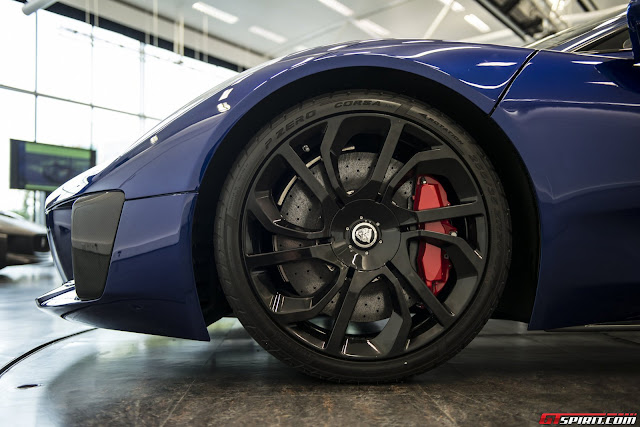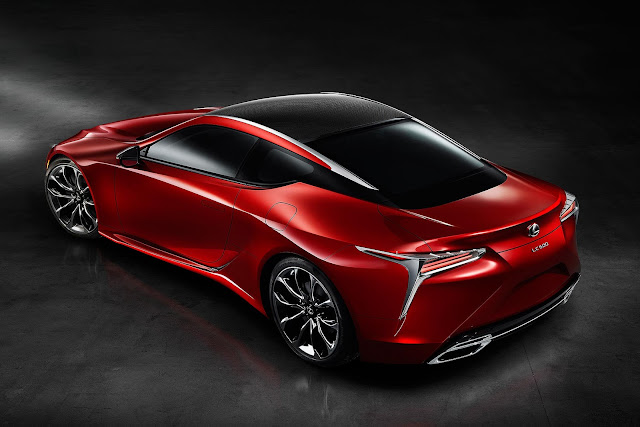C-X75 - THE MOST ADVANCED JAGUAR EVER CREATED
When Jaguar unveiled the C-X75 in 2010, it was the beginning of a new chapter in innovation and technological advancement that would see the car evolve from a design concept to a fully working prototype in just two years.In that incredibly short time span, Jaguar and development partner Williams Advanced Engineering have created an all-wheel drive, plug-in parallel hybrid electric vehicle (PHEV) with the world's highest specific power engine and Jaguar's first carbon composite monocoque chassis.
Although the decision was taken in 2012 that as a result of the global economic climate the C-X75 would not enter full production, it was clear that it was a powerful showcase for Jaguar’s world-leading expertise in lightweight vehicle construction and the ideal test-bed for the company’s innovative research into high-performance, low emission powertrains.
The great achievements in the development of C-X75 prototypes, including cutting-edge hybrid technologies, carbon composite materials and advanced design solutions pioneered in association with Williams Advanced Engineering will be utilised in other areas of research and development, innovative future products and next-generation engineering for the Jaguar brand.
“The C-X75 programme represents the pinnacle of Jaguar's engineering and design expertise. It is arguably the world's fastest test-bed for the world's most advanced technologies, combining as it does a remarkable hybrid powertrain with awe-inspiring performance. Jaguar is always looking to shape the cars of tomorrow and with projects like C-X75 we are laying the foundations for the next generation of Jaguar innovations.”- Adrian Hallmark, Global Brand Director, Jaguar.
Highest power and torque density
The C-X75 has a combined power output in excess of 850bhp and 1000Nm of torque, thanks to its state-of-the-art, Formula 1-inspired, 1.6-litre dual-boosted (turbocharged and supercharged) four-cylinder powerplant which generates 502 bhp at 10,000 rpm.
It is allied to the highest torque and power density electric motors in production, which generate a further 390 horsepower. The battery pack in the C-X75 is the highest continuously rated power PHEV pack in the world, capable of delivering more than 300kW over the full state of the charge window.
The C-X75 can sprint from 0-100mph in less than six seconds, thanks to its advanced 7-speed automated manual transmission that allows gearshifts in under 200 milliseconds. The very first C-X75 prototype exceeded 200mph in testing with ease, and the car has a theoretical maximum velocity of 220mph.
The car's deployable aerofoil and underfloor aerodynamics create more than 200kg of downforce at 200mph, and active systems enhance its high-speed stability.
Ultra low emissions and pure electric mode
Thanks to the most extreme PHEV specification of any mobile battery in development, the C-X75 will also run for 60km in pure electric vehicle mode and its CO2 emissions fall below 89g/km.
The C-X75 project allows Jaguar to stake an even stronger claim as the UK's most significant investor in innovative technology. The results of the C-X75 programme, in particular in advanced powertrain technologies and lightweight composites, demonstrate Jaguar's technical leadership at the very cutting-edge of automotive development and manufacturing.
The timing of this automotive engineering project was to celebrate the significant milestone of 75 years of Jaguar Cars and to emphasize to the world how the innovative heritage of Jaguar and the UK car industry can lead the next generation of powertrain and vehicle development. This project was not only a showcase in technical innovation but also in rapid product development with strategic partners such as Williams Advanced Engineering and Lotus can raise the bar in project delivery technical complexity and timescales.
The platform for the launch of this vision to the world was Paris. The show car was presented at the 2010 motorshow, drawing attention from the media, competitors, suppliers and the public to its blend of classic beauty and innovation. The thinking behind C-X75 is to provide an owner with a unique car, capable of being driven as a road vehicle showing style with economy, then on occasion, take it to the race track to unleash its performance and power.
The decision was made in May 2011 to go forward to the next stage of the supercar development and engineer the concept into a production solution, based on 250 vehicles. Jaguar’s Programme and Vehicle Manager, Rob Atkin with Paul Newsome Head of Williams Advanced Engineering led the programme and engineering activities from Grove Oxfordshire under the guidance a steering committee chaired by Bob Joyce Jaguar’s Engineering Director.
To deliver this task the newly formed Jaguar / Williams project team carefully selected key suppliers that were competitive, experienced and focused on delivery. Lotus were selected as a key partner to develop two major function groups: the chassis system and the engine management system. This technical delivery was managed under the guidance of Paul Pywell, Head of Lotus.
To deliver the chassis and engine management systems meant working closely with the core programme team. Lotus brought its 60 years of motorsport, car production and engineering collaborative consultancy experience with OEMs to bring a blend of process and flexibility to meet the challenge.
Key vehicle attributes
One of the major challenges for the automotive industry is to drive down CO2 emissions. The key enablers for this are to engineer cleaner downsized engines coupled with hybrid technology and lighter vehicles to get more power per kg. It was important to think outside the box to capture the right technology content, reduce time to market and cost whilst improving performance and customer appeal. This is what the team set out to do.After a review of the Paris concept car the technology moved away from the idea of micro gas turbines which uses jets to generate electricity for the battery and extend the range of the car. The technology direction was to develop a plug-in hybrid electric vehicle solution (PHEV) with a unique liquid and battery pack for this performance vehicle. This direction change allowed alignment with current production technology trends for CO2 reduction. Coupling boosted engine performance with additional power delivered from the battery through twin electric motor drives delivered additional performance.
The interior
Specification
- Supercharged 1.6-litre turbo petrol, 500 bhp
- Power output 313 bhp/litre compared to the Bugatti Veyron, 125 bhp/litre
- Twin electric motors developing more than 175 bhp electric motor on each axle
- Total power more than 850 bhp
- Torque more than 738 lbft
- Range of up to 60 miles on electric-only power
- Engine and rear electric motor drive coupled to 7 speed automated manual transmission
- The vehicle can be driven electrically or as a hybrid with 4WD
- High level of technology leveraged from Formula 1 including engine, high voltage battery, vehicle control system and aerodynamics
- Electric front axle drive, driving through a single speed reduction gearbox
Sources: http://www.jaguar.com/about-jaguar/concept-cars/cx75.html and https://lotusproactive.wordpress.com/2014/04/08/jaguar-c-x75-a-demonstration-of-the-future/

















































